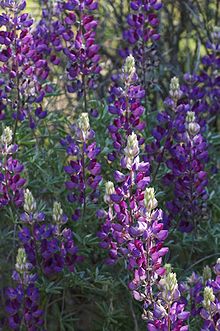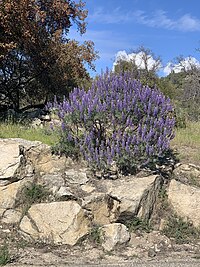
Lupinus polyphyllus, the large-leaved lupine, big-leaved lupine, many-leaved lupine, blue-pod lupine, or, primarily in cultivation, garden lupin, is a species of lupine (lupin) native to western North America from southern Alaska and British Columbia and western Wyoming, and south to Utah and California. It commonly grows along streams and creeks, preferring moist habitats.

Lupinus, commonly known as lupin, lupine, or regionally bluebonnet etc., is a genus of plants in the legume family Fabaceae. The genus includes over 199 species, with centers of diversity in North and South America. Smaller centers occur in North Africa and the Mediterranean. They are widely cultivated, both as a food source and as ornamental plants, but are invasive to some areas.
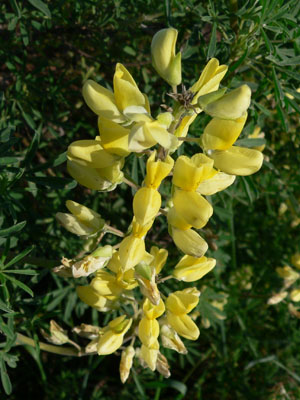
Lupinus arboreus, the yellow bush lupine (US) or tree lupin (UK), is a species of flowering plant in the legume family Fabaceae.

The Northern California coastal forests are a temperate coniferous forests ecoregion of coastal Northern California and southwestern Oregon.

Coastal sage scrub, also known as coastal scrub, CSS, or soft chaparral, is a low scrubland plant community of the California coastal sage and chaparral subecoregion, found in coastal California and northwestern coastal Baja California. It is within the California chaparral and woodlands ecoregion, of the Mediterranean forests, woodlands, and scrub biome.
Northern coastal scrub is a scrubland plant community of California and Oregon. It occurs along the Pacific Coast from Point Sur on the Central California coast in Monterey County, California, to southern Oregon. It frequently forms a landscape mosaic with coastal prairie.

Eriogonum fasciculatum is a species of wild buckwheat known by the common names California buckwheat and flat-topped buckwheat. Characterized by small, white and pink flower clusters that give off a cottony effect, this species grows variably from a patchy mat to a wide shrub, with the flowers turning a rusty color after blooming. This plant is of great benefit across its various habitats, providing an important food resource for a diversity of insect and mammal species. It also provides numerous ecosystem services for humans, including erosion control, post-fire mitigation, increases in crop yields when planted in hedgerows, and high habitat restoration value.
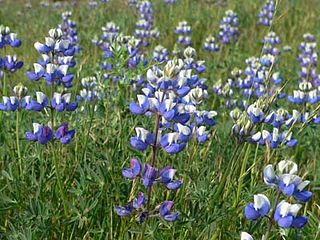
Lupinus nanus, the sky lupine, field lupine, dwarf lupin, ocean-blue lupine or Douglas' annual lupine, is a species of lupine native to the western United States. It is found natively in California, Nevada, and on Steens Mountain in eastern Oregon. It tends to grow on slopes and in open or disturbed areas below 1300 meters.
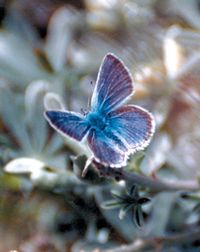
The Mission blue is a blue or lycaenid butterfly subspecies native to the San Francisco Bay Area of the United States. The butterfly has been declared as endangered by the US federal government. It is a subspecies of Boisduval's blue.

The U.S. Fish and Wildlife Service (USFWS) has a number of programs aimed at Mission blue butterfly habitat conservation, which include lands traditionally inhabited by the Mission blue butterfly, an endangered species. A recovery plan, drawn up by the U.S. Fish and Wildlife Service in 1984, outlined the need to protect Mission blue habitat and to repair habitat damaged by urbanization, off highway vehicle traffic, and invasion by exotic, non-native plants. An example of the type of work being done by governmental and citizen agencies can be found at the Marin Headlands in the Golden Gate National Recreation Area. In addition, regular wildfires have opened new habitat conservation opportunities as well as damaging existing ones.

Lupinus bicolor is a species of lupine known as the miniature lupine, Lindley's annual lupine, pigmy-leaved lupine, or bicolor lupine.

Leymus condensatus, the giant wildrye, is a wild rye grass native to eastern Oregon, California and northern Mexico.
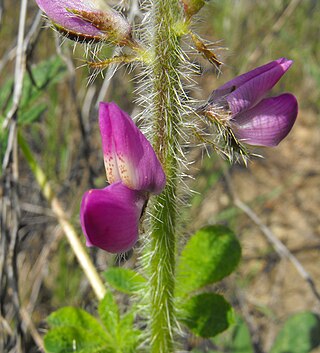
Lupinus hirsutissimus is a species of lupine known by the common names stinging annual lupine or stinging lupine. It is native to the coastal mountains of Baja California and Southern California as far north as the San Francisco Bay Area. It grows on dry mountain slopes, including areas that have recently burned, and chaparral and woodlands habitats.

Lupinus longifolius is a species of lupine known by the common name longleaf bush lupine.

The California coastal sage and chaparral is a Mediterranean forests, woodlands, and scrub ecoregion, defined by the World Wildlife Fund, located in southwestern California and northwestern Baja California (Mexico). It is part of the larger California chaparral and woodlands ecoregion. The ecoregion corresponds to the USDA Southern California ecoregion section 261B, and to the EPA Southern California/Northern Baja Coast ecoregion 8.

Salvia munzii is a semi-evergreen perennial species of sage known by the common name Munz's sage or San Miguel Mountain sage. It is native to northern Baja California, Mexico, and it can be found in a few locations just north of the border in San Diego County, California, where it is particularly rare. It is characterized by small leaves and clear blue flowers. It is a member of the coastal sage scrub and chaparral plant communities.

The Palos Verdes Peninsula Land Conservancy (PVPLC) is a non-profit organization that is based on the Palos Verdes Peninsula in southwestern Los Angeles County, California.

Eriogonum elongatum, commonly known as longstem buckwheat or wand buckwheat, is a species of wild buckwheat native to coastal southern and Baja California.
Lupinus prunophilus, commonly known as the hairy bigleaf lupine or chokecherry lupin, is a medium-sized herbaceous plant that grows in the Great Basin and other parts of the U.S. interior between the Sierra-Nevada and the Rockies. It is a close relative and very similar to Lupinus polyphyllus and is considered a subspecies by some botanists.

Lupinus caudatus is a widespread species of wildflower in genus Lupinus from western North America known by the common names tailcup lupin and spurred lupin. It is distinctive for the short spur on its purple-blue flowers, for which it is named. Because of its wide distribution and toxicity it commonly causes poisonings of susceptible livestock such as horses, cattle, and sheep, though it is eaten without harm by wild herbivores like deer and elk. It is generally found from the Coastal Ranges and Sierra Nevada Mountains in the west to the Rocky Mountains in the east.
